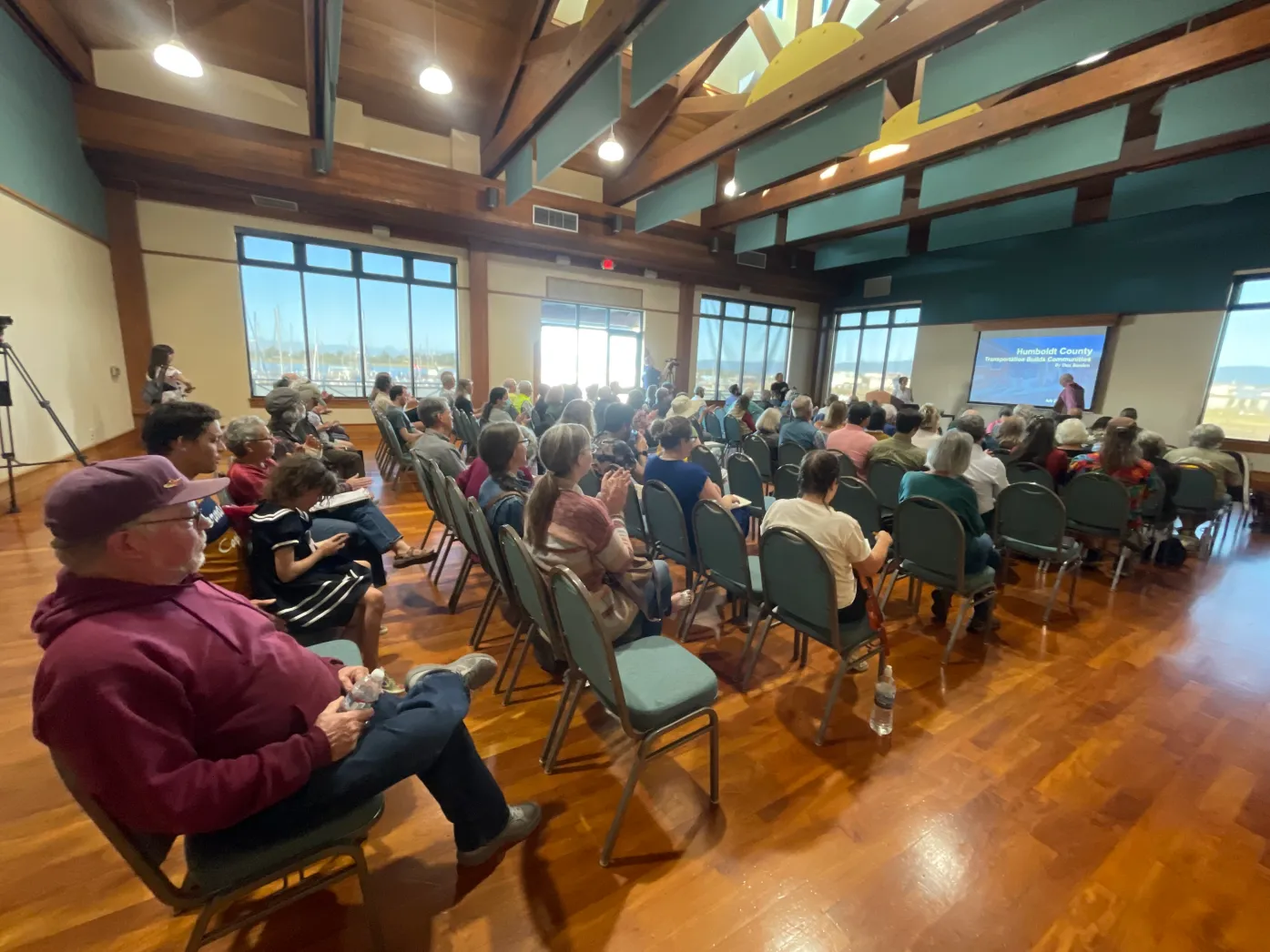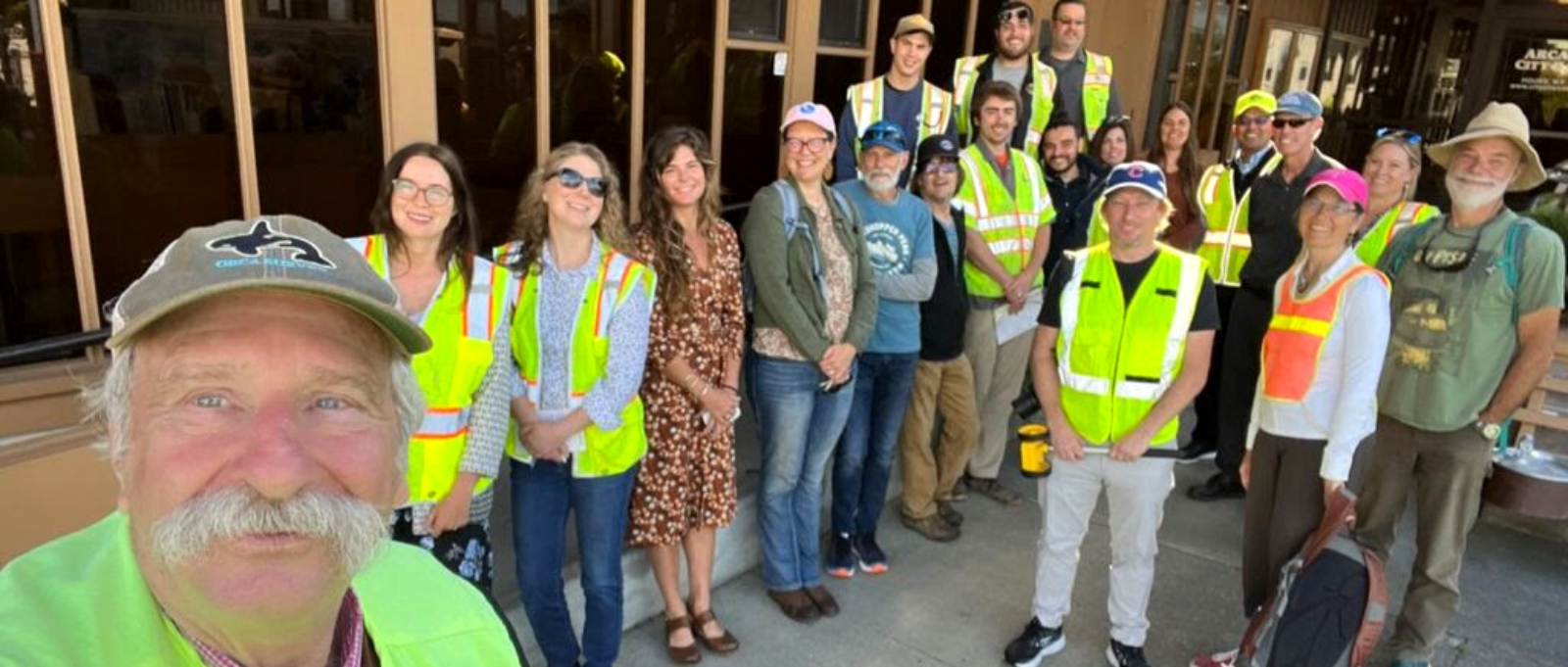September 28, 2023
Topic
Late July was a busy time in Humboldt County. The Humboldt County Association of Governments (HCAOG) brought in Dan Burden—renowned walkability expert and a pioneer in people-first urban planning—and CivicWell for a series of events to explore ways to make local communities more pedestrian-friendly.
HCAOG reached out to Burden because twenty years ago he had passed through the area, and the vision and tools of people-first community planning made a big impact on local leaders who carried them forward in the decades that followed. CivicWell, a longtime partner of both Burden and communities in the Humboldt region, stepped in to aid with community outreach, facilitation, solution brainstorming, and funding expertise.
Over four days the cities of Arcata and Eureka, and Humboldt County with the communities of Blue Lake and McKinleyville, hosted a series of walk and bike audits to identify potential improvements to street safety, trails, bike lane connectivity, and traffic calming. Each community’s officials selected a priority area and shared background information on projects being planned and the traffic and pedestrian-related issues faced.
“Here’s a fairly simple principle and that is — stop over-building for the car, and start building for people and place.”
Dan Burden

Public participation at the events was high, with large groups of yellow-vested walkers and bicyclists traversing well-used paths, busy corridors, main streets, and town squares. Armed with cameras, measuring tapes and wheels, Burden and CivicWell Community Design Program Director Josh Meyer called out elements along the way that contribute or detract from creating walkable thriving places. At one point Burden organized participants into a “human bulbout” to show the effect of extending curbs into the street to shorten crossings, calm traffic, and convert excess pavement into sidewalk space for pedestrians.
According to an article in the Times-Standard, “G. Mario Fernandez, a Eureka city council member, attended the audit near Old Town and noted that Burden suggested more sidewalk ramps, increased width of sidewalks, improved line of sight of the area and general consistency across the walking environment of this area of the city…Overall, he encouraged cities to decide on what the communities value and make changes based on this input, rather than leaving the design up to developers of the past.”
After the audits were completed, Burden and Meyer shared findings and recommendations to community members at well-attended presentations. The recommendations for making communities more pedestrian-friendly included, among other things:
- adding curb ramps
- widening sidewalks
- maximizing the use of curb extensions
- adding planter “buffer zones” between the sidewalk and car traffic
- improving line of sight at intersections
- expanding the tree canopy
- installing roundabouts at intersections
- narrowing car lanes
- adding buffered bike lanes
“From longtime Board representation from the region to helping establish the Redwood Coast Energy Authority, CivicWell has a strong history of partnership with local leaders in the Humboldt area. We were honored to be part of this fruitful event series, and excited to see that community members continue to be enthusiastic, engaged, and highly informed.”
Josh Meyer
These events are part of a larger effort by local elected officials, agency leaders, and community champions in the region to bring people-centered updates to communities. They have recently been awarded several grants including a Caltrans Sustainable Communities Grant to develop the City of Eureka Bike Plan, a grant to make the 101 overpass on Samoa Blvd in the City of Arcata safer for active transportation, and another for a “road diet” in the community of McKinleyville.
For more information on how CivicWell can support engagement and planning in your community, see our Participatory Planning and Design, Workshops, and Direct Assistance services.

Policy Corner
Tackling GHG Emissions from the Transportation Sector
As the first year of the legislative session has come to a close, and the attention turns to which bills Governor Gavin Newsom will sign, action on climate change remains a focal point. Indeed, the Governor spent Climate Week in New York touting California’s leadership on tackling climate change aggressively.
In support of his assertion, the Governor cited signing SB 253 by Senator Scott Wiener and SB 261 by Senator Henry Stern. SB 253 will require any corporation that has total revenues over $1 billion per year and is doing business in California to report its greenhouse gas (GHG) emissions on an annual basis. SB 261 will require any company (other than insurance companies) that has more than $500 million in annual revenues and is doing business in California to report its climate-related financial risk on a biennial basis.
These bills are, without doubt, groundbreaking and join other climate-related bills that the Governor is expected to sign. But what has been missing from the legislative accomplishments on climate the last several years is meaningfully addressing the need to reduce GHG emissions in the transportation sector.
Transportation accounts for more than 40% of the GHG emissions in the state. Without prioritizing transportation projects that will substantially reduce such emissions in the next decade, the state will have no chance of meeting its goal of reducing GHG emissions overall by at least 40% below 1990 levels by 2030 and net zero emissions no later than 2045. While the continuing transition to electric vehicles (EVs) will make a difference, that transition alone will not come close to producing the level of emission reductions needed.
Recognizing the imperative of modifying our criteria for transportation project investments to prioritize GHG emission reductions, Assemblymember Laura Friedman has authored four bills over the past two years to take on this issue. Assemblymember Friedman has sought to build on the transformative SB 375 by Senator Darrell Steinberg in 2008 and the Newsom Administration’s California Action Plan for Transportation Infrastructure (CAPTI) to ensure that climate impacts are fully incorporated into local and state transportation investment decisions.
In 2022, Assemblymember Friedman authored AB 2237 to strengthen the requirement of SB 375 that local governments invest in projects that would reduce vehicle miles traveled (VMT) and GHG emissions. The bill, however, stalled in the Senate Transportation Committee. She also carried AB 2438, which would have infused the climate-based principles of CAPTI into state law. However, Governor Newsom vetoed the bill.
Starting over in 2023, Assemblymember Friedman introduced AB 6 and AB 7. Although the bills differ in the details from AB 2237 and AB 2438, the essence of the legislation remains the same–to ensure that local and state transportation investment decisions fully reflect the necessity to reduce GHG emissions.
While the bills both cleared the state Assembly this year, sufficient resistance from a variety of interest groups and a lack of clear direction from the Newsom Administration has forced Assemblymember Friedman to hold the bills until next year when the Legislature returns.
With so many diverse groups and organizations—including local governments, construction and development advocates, organized labor, and state agencies—holding divergent perspectives but sharing the view that significant change in the decision-making process for transportation investments could be adverse to their interests, it is easy to understand why attacking climate change in the transportation sector is so challenging. Now, we will have to wait to see if the impacts of climate change that we are all experiencing will be enough to bring the change that is so critically necessary.
Share Your Input on the California Water Plan Update
Give DWR your input on the Draft of California Water Plan Update 2023 and help improve water management decisions. DWR will collect all comments to shape the final document. Please contact cwpcom@water.ca.gov with any questions. DWR also hosting a 2-day Plenary to review the Draft of California Water Plan 2023, see details below.
How to Comment: Public comments can be made through October 19, 2023. There are three options to submit public comments:
-
Completing an online form
-
Submitting comments via e-mail to cwpcom@water.ca.gov
-
Postal Mail: Attn: Francisco Guzman, California Water Plan Update 2023, California Department of Water Resources, 715 P Street, 6th Floor, Sacramento, CA 95814
Comments can be collected by chapters or sections including Executive Summary.
How to Learn More – Attend the California Water Plan Update 2023 Plenary
To learn more and engage with the authors of the plan, DWR is hosting the California Water Plan Update 2023 Plenary on October 3 and 4 at the Roebbelen Center @The Grounds in Roseville, CA. This FREE hybrid event will feature keynote speakers and cover key aspects of California Water Plan Update 2023. Attendees will gain more insight into the plan, have an opportunity to ask questions and offer direct feedback. Registration is now open for in-person and online attendance.






